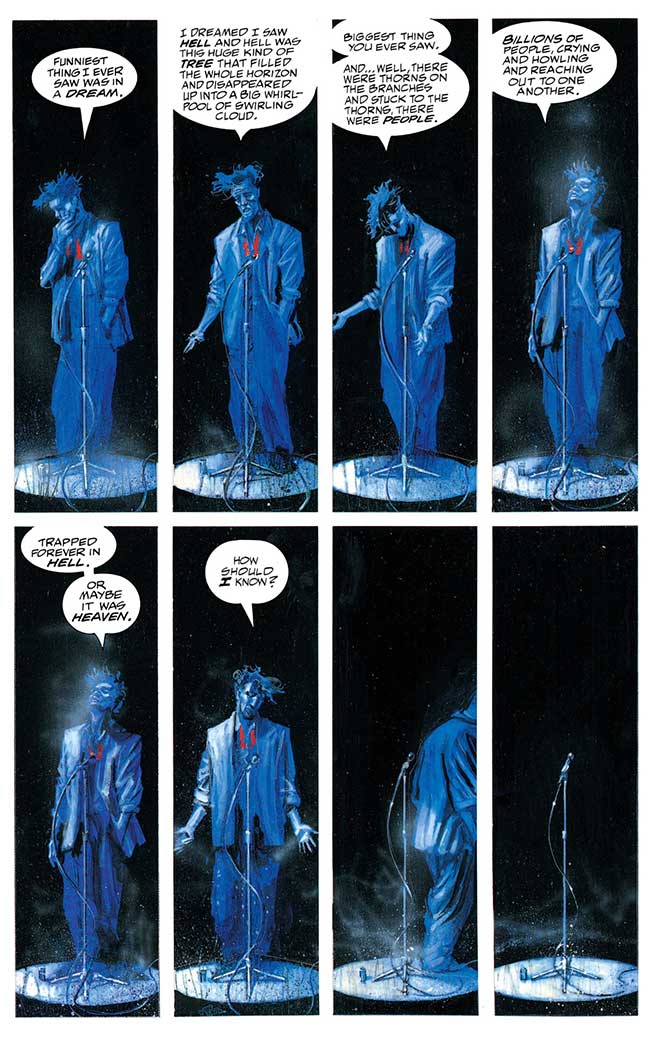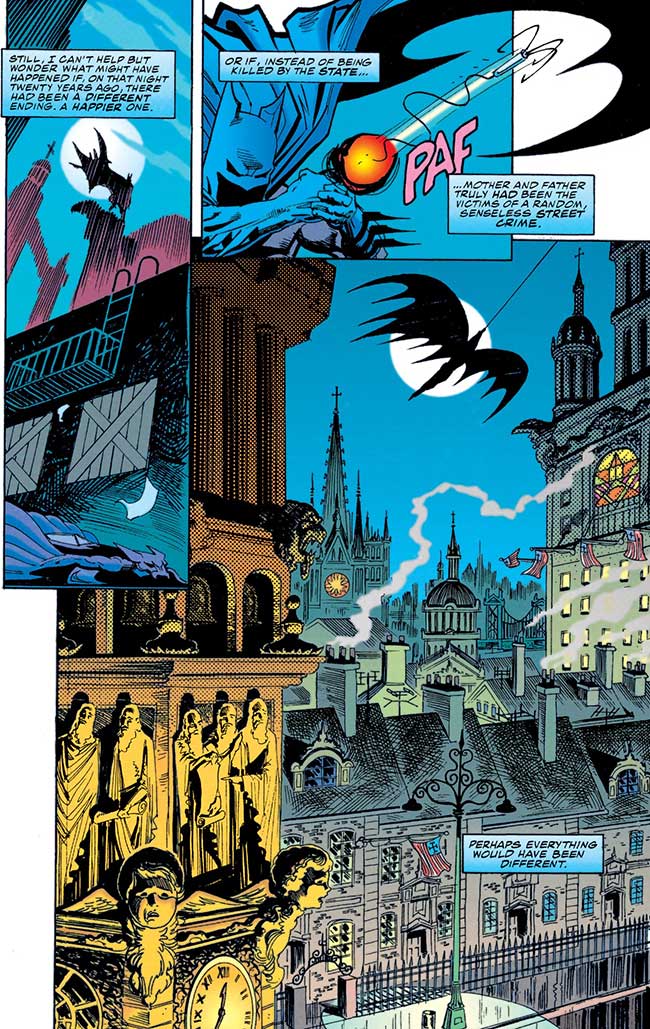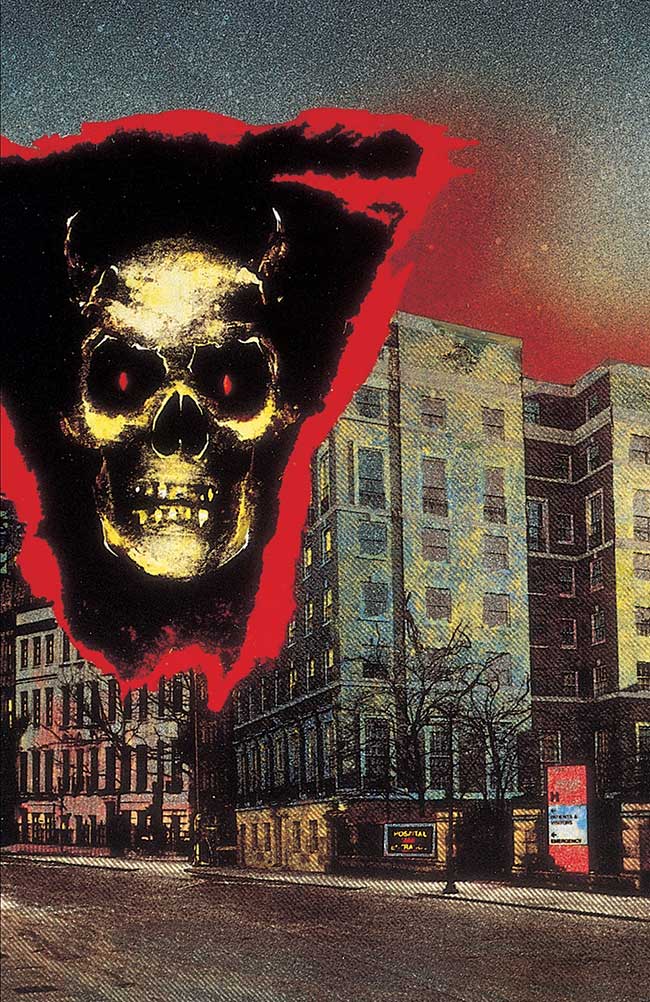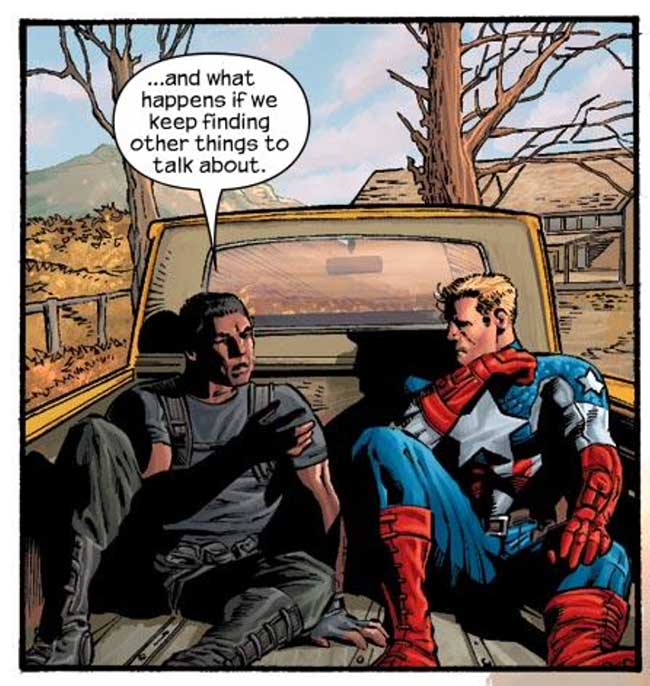Rand Bellavia (one half of the musical group Ookla the Mok) returns for another trip down memory lane to look at 40 years of his favorite comics in this week’s Random Access Memory.
August 1981
Avengers 213
I would love to know what it was about poor Henry Pym that caused Jim Shooter to hate him so much. Those of you wondering how Pym went from “Henry Pym: Founding Avengers, Respected Scientist, Inventor of the Pym Particle” to “Henry Pym: Wife Beater” should consult this issue.
Recently, Shooter came out of the woodwork to claim that his original script called for Pym to accidentally strike Janet while trying to push her out of the way, leaving us to assume that it was artist Bob Hall’s “dynamic” interpretation of Shooter’s script that elevated Pym’s accidental push to spousal assault. But Janet sure doesn’t act like it was an accident. And why didn’t Shooter exercise any of his power as Avengers writer – or Marvel Editor-in-Chief – to correct this misunderstanding? Shooter’s last Avengers issue (224) found Henry Pym in prison for murder (!) and new writer Roger Stern spent the first four issues of his run attempting to give Pym’s character some measure of dignity and redemption.
Avengers Annual 10
Speaking of other writer’s picking up the pieces of characters that Jim Shooter shattered, this annual – written by Christ Claremont – came out exactly a year after Shooter’s double-sized Avengers 200, which climaxed with Carol Danvers, then Ms. Marvel, abruptly leaving the Avengers – and this plane of existence – to shack up in limbo with some guy named Marcus, who the Avengers met that very issue.
In fact, he began the issue as an infant.
That Carol gave birth to.
And it gets worse. While “reminding” Carol of their time together as lovers (when he, apparently, impregnated her with himself – an act that she has no memory of), Marcus says the following, out loud, in front of Iron Man, Thor, and Hawkeye:
Did you catch that? Well, Chris Claremont sure did. So, a year later, he gave Carol the platform she needed to vent her anger, frustration, and sorrow at the Avengers for letting her down at her most vulnerable moment.
Oh yeah, and this issue features the first appearance of Rogue, for all you X-fans.
Flaming Carrot Comics 1
Most of you probably know Bob Burden as the creator of the Mystery Men, the intentionally lame super-hero team made moderately famous by a 1999 feature film. He has also been responsible for some genuinely hilarious Gumby comics. But the Flaming Carrot is where all the zaniness began.
A huge part of Burden’s charm is his uncanny ability to tap directly into the raw creativity that is usually reserved for children and the insane. The first time I saw Mystery Men, I had a hard time believing an adult human named a super-villain Casanova Frankenstein. There’s a purity there that people lose access to as they enter adolescence. Burden’s work is rife with this purity, and nowhere is it less constrained than these early issues of Flaming Carrot.
August 1986
Marvel Fanfare 29
My childhood love for John Byrne continued into my teen years, leading me to – for the first time in my life – collect the Incredible Hulk when he took over as writer and penciller. He was coming off a lengthy run on Alpha Flight, and – as I recall – after a brief cross-over, the two books swapped creative teams. I don’t know how long Bill Mantlo lasted on Alpha Flight, but six short months later Byrne abruptly left the Hulk. My disappointment was heightened when I read that a planned issue – comprised entirely of splash pages – was not to be. Then, inevitably, it ended up in an issue of Marvel Fanfare.
Marvel Fanfare was intended to be Marvel-Zilla: The best writers and the best artists telling the best stories with the best characters on the best paper! (And no ads!) The first four issues lived up to the hype, with a Marvel Universe spanning four-issue story written by Chris Claremont and illustrated by Michael Golden – the same team on the Avengers Annual discussed above. But it didn’t take long for the mission statement to change from “a showcase for the industry’s top talent” to “a place to publish unused inventory stories.”
Which brings us to issue 29, and the eventual publication of John Byrne’s all-splash page issue of the Incredible Hulk. You will believe a comic book fan can say “meh.”
Swamp Thing 54
I have a vivid of memory of first reading this issue. I had just spent two weeks at a “National Leadership Conference” (please don’t ask) and was flying home just in time for my parents to pick me up and whisk me directly to a Monkees concert. Back then, the idea of the Monkees touring was an amazing novelty, and something I was genuinely excited about. (Did I mention that their warm up act was “Weird Al” Yankovic?) On this, their first reunion tour, the Monkees consisted of Davy Jones, Mickey Dolenz, and Peter Tork. Mike Nesmith* sat this one out.
At this point, I was ordering my comics through a popular mailing service called Westfield Comics. To give some indication of what a comic book nerd I was at the time, my parents knew to bring my stack of comics, so I could look through them on the car ride from the airport to the concert. Swamp Thing 54 was the comic I chose to read during the brief car ride.
*Fans of pop culture minutia will remember Mike Nesmith as the last Monkee to run out of money.
August 1991
Batman: Holy Terror
For whatever reason, the whole Elseworlds concept never grabbed me. But, being obsessed with both comic books and theology – did I mention I have a graduate degree in theological studies, and my masters thesis used comics as primary sources? – I couldn’t resist checking this one out. (I should add that while this wasn’t the first Elseworlds title – I believe that was Gotham by Gaslight – this was the first comic to bear the Elseworlds logo.)
It always seemed to me that the primary engine driving Marvel’s What If? concept was the notion that any change, no matter how small or seemingly insignificant, would result in the destruction of the Universe. “What if The Avengers never discovered Captain American’s frozen body?” The Universe would explode. “What if Uncle Ben didn’t die?” The Universe would explode. “What if Henry Pym was Yellow Jacket before he was Giant-Man?” The Universe would explode.
DC’s Elseworlds line appears to have the opposite problem, as the main point of most Elseworlds stories seems to be that no matter what you change about the characters or their surroundings, everything will turn out pretty much the same.
In this story, Bruce Wayne is born in an America run by a corrupt theocracy. His parents still get killed, but in this case it’s a government conspiracy. Bruce plans to become a priest, but soon learns the dark truth about the world he’s in, and – prepare for a shocking left turn – responds by putting on a Bat suit and fighting crime. Oddly, the story ends with Bruce wondering if everything might have been different if his parents had been killed by… oh, I don’t know, let’s say a random mugger.
This is silly for several reasons. First of all, just how screwed up is Bruce Wayne? I’d like to think that he would fantasize about living in an alternate reality where his parents weren’t brutally killed when he was ten years old. But, more importantly, isn’t the whole “I wonder what might have been” trope meant to be a wink at the audience who know exactly how different things would have been? Like, if the story was about an accountant named Paul McCartney, at the end he’d say, “And I can’t help but wonder how different my life might be if I’d had the courage to approach that John Lennon fellow that one day” and we’d all get it. But why would Bruce muse about how different things might have been had his parents been killed by a mugger, when we know that – in “our” reality – that exact thing happened, and it all turned out exactly the same, anyway? Is this some sort of Newspeak doubleplusirony that I’m missing?
And, for you armchair theologians, the spiritual message is simple, but well stated: Don’t confuse God with those who claim to speak for God.
I should probably also point out that this one-shot was put back into print a few weeks ago in the Tales of the Batman: Alan Brennert collection.
Lastly: how did no one remember this book when Frank Miller pitched “Holy Terror” as the title of his Batman vs. Osama Bin Laden graphic novel in 2002? (If you’re unfamiliar with this concept, consult the underwhelming NOT AT ALL BATMAN and CERTAINLY NOT CATWOMAN graphic novel Holy Terror.)
Doom Patrol 47
After the success of his Punisher parody (The Beard Hunter, in issue 45) Morrison seemed emboldened to riff on existing comics characters more frequently, leading to an almost Cerebus-level of character parody/homage, which climaxed – depending on your level of schadenfreude – either with issue 53’s loving tribute to Kirby’s Fantastic Four, or the Doom Force special’s merciless take-down of Rob Liefeld’s X-Force.
So, failing to receive permission to use John Constantine in his Doom Patrol run, Morrison simply created Willoughby Kipling, a brilliantly funny John Constantine stand in.
This same issue introduces us to The Shadowy Mr. Evans, who – at first – appears to be just another batshit-crazy Doom Patrol villain, but ends up being a pretty funny Mr. Mxyzptlk parody. (More on that next month/issue, along with a perhaps too obvious X-Men/X-Files parody.)

I don’t know if this was Morrison’s intention, but the first time I saw this:

I couldn’t help but think of the Howard the Duck villain Doctor Bong. Was I the only one?

Hellblazer 46
Dangerous Habits ends, and a million Garth Ennis fans are born. The art is a bit of a rush job – Will Simpson’s sloppy but appealing artwork is simply sloppy – but Ennis’ script more than rises above the mediocre art. Eventually, Ennis is paired with the amazing Steve Dillon, and they ride the Hellblazer train all the way to the Preacher station, but anyone out there wondering what John Constantine (or Garth Ennis) is all about, could do much worse than checking this storyline out.
Kid Eternity 3
This one’s a bit of a mess – and far from the strongest work by either Grant Morrison or Duncan Fegredo (who wisely put his paint brush done and picked his pencil back up after this mini-series) – but a few moments of greatness shine through.
The main character in this story is a stand-up comedian, and several pages of the comic are devoted to “clips” from his unexpectedly popular stand-up special. I have to imagine I’m not the only one out there who has this pet peeve: Stories about stand-up comedians – or sketch comedy shows (Studio 60 on the Sunset Strip, I’m looking at you) – that are utterly devoid of humor. I’m not talking about a serious take on the day to day life of a stand-up comedian. That’s fine. But, if you can’t be bothered to write some good jokes, then please refrain from including scenes of the comedian on stage (unless, of course, your point is that the comedian is not very good).
That being said, my favorite page in the entire comic is one of the aforementioned pages of stand-up. In fact, it’s the final page of the series.

Marc Spector: Moon Knight 31
Scarlet Redemption, J.M. DeMatteis’ single six-issue Moon Knight story line, ends here. During his brief run, DeMattis not only completely reinvented the character, but managed to do so in a manner that made good sense in the context of the character’s history.
Moon Knight’s origin in thirty seconds: Marc Spector was a mercenary – and not a particularly nice one. He unexpectedly found his conscience, refusing to kill innocent people, and was killed for his trouble. The Eqyptian God Khonshu brought him back to life, giving him a second chance, and naming him Khonshu’s avatar on earth.
Apparently confusing this rather straight-forward origin story with Batman’s, Spector puts on a cloak and roamed the night, beating up petty criminals as the “Fist of Khonshu.”
(There’s also something about having three secret identities – or a split personality, depending on the writer – but that’s not important now.)
DeMatteis correctly understood that when you’re a bad man who lived a bad life, and end up getting killed because of a single act of kindness, and then a deity bring you back from the dead and asks you to spread his gospel, maybe not so much with the beating up bad guys thing. During this run, Spector comes to realize the contradictory nature of his existence as Moon Knight – he was given a second chance but refuses to offer the same grace to the criminals he encounters – and Scarlet Redemption ends with Spector committing to the path of grace.
For nearly an entire issue! Literally, the very next issue ends with Spector realizing what a simpering pansy he’d been , and recommitting to the path of physically abusing brown people.
X-Factor 71
This, by the way, is the month that X-Men 1 came out. As in, the Jim Lee Illustrated X-Men debut issue that (thanks to five interlocking variant covers and a whole lot of very stupid speculators) sold over eight million copies! Always a contrarian at heart, I didn’t so much enjoy the Claremont/Lee X-Men, nor the Byrne/Portacio Uncanny X-Man book that re-launched at the same time. But Peter David and Larry Stroman’s reimagining of X-Factor was right up my alley.
The two main X-Men books divided the mutant spoils, taking all the good and/or popular characters between them. This left Peter David with the following team: Havok, Polaris, Quicksilver, Multiple Man, Wolfsbane, and – no shit – Strong Guy. Bear in mind that the previous X-Factor team was Cyclops, Marvel Girl, Angel, Ice-Man, and the Beast. Yet David made these characters work – sing, even. Some referred to this as the “funny” X-book, and while this is certainly true, at the time I referred to it as the “readable” X-book.
August 1996
Hitman 6
Like Preacher, Hitman finds a strange balance between in-your-face zany adventures and a genuine meditation on masculine friendship. While the first Hitman storyline was heavy on the zany adventure, Ten Thousand Bullets, while providing plenty of action, also establishes the emotional core of the series by introducing Tommy’s best friend Nat then almost immediately killing Tommy’s “other best friend” Pat.
At the time of Pat’s death, all we really know about him is that he’s Tommy’s childhood best friend, and has never really had to stand up for himself. Like so many young men, he confuses true adulthood with the social construct of masculinity (communicated as much through the popular culture as it is through the streets) and foolishly assumes Tommy will love and respect him more for being a “tough guy” than for finding a way to stay alive.
Of course, we’re much too early in the series for Tommy to confront his own hypocrisy, so instead of owning up to how his violent actions are creating a swirling vortex that will eventually suck him and all of his friends under, he responds to the death of his best friend by surrendering to his action hero programming:
Preacher 18
Garth Ennis has always been a huge fan of war stories, and before his popularity allowed him to write whatever the hell he wanted – i.e., a whole lot of war stories – he had to find ways to cram war stories into the super-hero, horror, and action comics he was writing. In this case: On the way to France to rescue Cassidy from the Grail, Jesse meets his father’s best friend from Vietnam at the airport. Cue war stories.
The stories Billy “Spaceman” Baker tells Jesse (here and in issue 50) not only flesh out Jesse’s father, but also happen to make some of the best comics in the entire run of Preacher.
Swamp Thing 171
Mark Millar’s Swamp Thing run comes to an end, as does (for the time being, at least) Swamp Thing. For whatever reason, I boarded the Mark Millar train way before it left the station. In 1990, somehow I saw an ad for a new book called The Saviour, put out by an obscure new UK company called Trident Comics. The author was an unknown teenager named Mark Millar. And I loved it. The book – and the company that published it – only lasted six issues. Funnily enough, the letters column from that last issue contained this:
It only took him four years (and one friendship with Grant Morrison), to make good on that threat. And while he did indeed burn Swamp Thing to the ground, he did it with style. See, back in the 90s, Mark Millar was a struggling comic book writer whose world view seemed for all the world to match with that of Mark Waid, Tom Peyer, and – of course – his mentor Grant Morrison. Millar’s comics had heart. They lacked cynicism. For God’s sake, he did a fantastic run on the kid-friendly Superman Adventures comic. Compare this ending with the last page of Wanted.
August 2001
Strange Stories for Strange Kids
This is volume two of Little Lit, a series of oversized hardcovers that collect some very odd children’s comics. This volume attracted a true all-star cast of creators: comics luminaries Art Spiegelman and Jules Feiffer, children’s lit legends Maurice Sendak and Crockett Johnson, and champions of prose Paul Auster and David Sedaris are among those who contributed original stories to this must-see collection.
August 2006
Ultimates Annual 2
If you don’t already know, the Ultimates was the name given to the “Ultimate Universe” version of the Avengers. If you’re not a regular reader of Marvel Comics, don’t let the title scare you off, as the Ultimates were the template Marvel used for the cinematic version of the Avengers, which is to say, these comics are much closer to what you see on screen than any Avengers comic you might pick up.
That being said, this isn’t really an Avengers story at all, as Captain America and the Falcon are the only Ultimates (Avengers, whatever) who appear in the issue. It’s a serviceable story, time-split, with half the action taking place during World War II and the other half during the present. For all of the action in the story, what sticks out to me is a brief conversational sequence between Cap and the Falcon that allows both men to express their profound frustration regarding the world they find themselves in at this moment in time.
August 2011
Justice League 1
Geoff Johns and Jim Lee on Justice League! The first New 52 title released! Why didn’t I like it more?
This was a fine comic, I suppose, but it didn’t really have that many ideas in it, did it? I did, however, really I enjoy the “What are Batman’s super-powers?” riff.
Mystic 1
I’m not really sure how I became a G. Willow Wilson fan – I think it may have been Air – but she got added to my “must read” list pretty early in the game. This was part of Marvel’s attempt to make use of the properties they bought from failed comic book company CrossGen. For my money, this and Mark Waid’s Ruse were the best of the lot.
Mystic was that perfect YA story that was genuinely entertaining for adults. Sure, you had a sense of where it was all going, but it was pure joy to see the characters put through their paces. Great stuff.
Wolverine 14
After writing enough Wolverine stories to fill an Omnibus – and before writing enough Wolverine and the X-men stories to fill a second Omnibus – Jason Aaron wrote a 14-issue Wolverine story about the revenge scheme of a group called the Red Right Hand. The final five issue arc – ironically titled “Wolverine’s Revenge” – ends here, with the Red Right Hand committing suicide just as Wolverine is about to confront them, and conveniently leaving behind an expository video for Wolverine to find.
I’m man enough to admit that I didn’t see that one coming, and it was genuinely shocking to read.
Dear Spoilerite,
At Major Spoilers, we strive to create original content that you find interesting and entertaining. Producing, writing, recording, editing, and researching requires significant resources. We pay writers, podcast hosts, and other staff members who work tirelessly to provide you with insights into the comic book, gaming, and pop culture industries. Help us keep MajorSpoilers.com strong. Become a Patron (and our superhero) today.














































